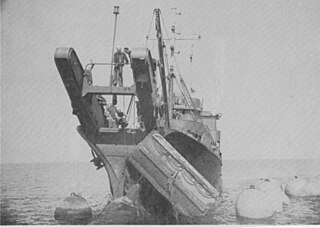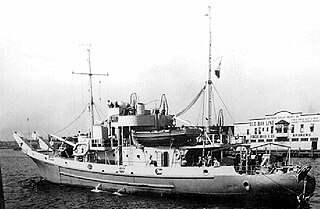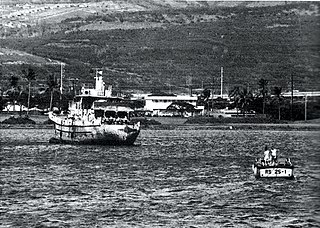
USS Etlah (YN-98/AN-79) was a Cohoes-class net laying ship built for the United States Navy during World War II. She was commissioned in April 1945 and spent her entire career in the Pacific Ocean. She was decommissioned in March 1947 and placed in reserve. She was recommissioned in August 1951 for Korean War service and remained active until May 1960. She was sold to the Dominican Republic in September 1976 as patrol vessel Cambiaso (P207). By 1994, Cambiaso had been removed from Dominican Navy service and hulked.
USS Chinquapin (YN-12/AN-17) was an Aloe-class net laying ship built for the United States Navy during World War II. Originally ordered as USS Fir (YN-2), she was renamed and renumbered to Chinquapin (YN-12) in October 1940 before construction began. She was launched in July 1941, and completed in October 1941. Placed in service at that time without being commissioned, she was commissioned in January 1943, and decommissioned in March 1946. She was placed in reserve at that time and scrapped in 1976.

USS Teak (AN-35/YN-30) was an Aloe-class net laying ship which served with the U.S. Navy in the Pacific Ocean theatre of operations during World War II. She was assigned to serve the U.S. Pacific Fleet with her protective anti-submarine nets and earned two battle stars and other commendations for her bravery.

USS Teaberry (AN-34/YN-29) was an Aloe-class net laying ship which was assigned to serve the U.S. Pacific Fleet during World War II with her protective anti-submarine nets and, at war's end, returned home safety with one battle star to her credit. She was later reactivated for duty during the Korean War era.

USS Sandalwood (YN-27/AN-32) was an Aloe-class net laying ship built for the United States Navy during World War II. She was later transferred to the French Navy as Luciole. She was stricken from the French Navy and sold to Malaysian owners, but her fate beyond that is unreported in secondary sources.
USS Rosewood (YN-26/AN-31) was an Aloe-class net laying ship built for the United States Navy during World War II. She was later transferred to the French Navy as Libellule (A730). She was sunk as a target near Brest in 1983.

USS Mulberry (AN-27/YN-22) was an Aloe-class net laying ship built for the United States Navy during World War II. She saw service in that conflict and the Korean War, earning one battle star for service in the latter conflict. She was decommissioned in April 1960 and placed in reserve. In November 1965, she was transferred to the Ecuadorian Navy as BAE Orion (HI-91). She was scrapped in 1980.
USS Mimosa (AN-26/YN-21) was an Aloe-class net laying ship which was assigned to serve the U.S. Navy during World War II with her protective anti-submarine nets.
USS Mango (AN-24/YN-19) was an Aloe-class net laying ship which was assigned to serve the U.S. Navy during World War II with her protective anti-submarine nets.

USS Locust (YN-17/AN-22) was an Aloe-class net laying ship built for the United States Navy during World War II. She was later transferred to the French Navy as Locuste (A765). She was sold to Malaysian owners but sank after striking a reef off Cikobia Island, Fiji, on 30 July 1978. She was towing the former French ship Scorpion, which also sank.
USS Holly (AN-19/YN-14) was an Aloe-class net laying ship which was assigned to serve the U.S. Navy during World War II with her protective anti-submarine nets.
USS Ebony (YN-10/AN-15) was an Aloe-class net laying ship built for the United States Navy during World War II. She was launched in June 1941, and completed in September 1941. Placed in service at that time without being commissioned, she was commissioned in May 1942, and decommissioned in March 1946. She was placed in reserve in 1946 and scrapped in 1976.
USS Buckthorn (YN-9/AN-14) was an Aloe-class net laying ship built for the United States Navy during World War II. Originally ordered as USS Dogwood (YN-3), she was renamed and renumbered to Buckthorn (YN-9) before construction began in December 1940. She was launched in March 1941, and completed in September 1941. Placed in service at that time without being commissioned, she was commissioned in December 1942, and decommissioned in August 1947. She was placed in reserve in 1947 and scrapped in 1976.

USS Buckeye (AN-13/YN-8) was an Aloe-class net laying ship in service with the United States Navy from 1942 to 1947. In the late 1970s and 1980s, she was used as a salvage training hulk.
USS Cinchona (AN-12/YN-7) was an Aloe-class net laying ship which was assigned to serve the U.S. Navy during World War II with her protective anti-submarine nets.
USS Chestnut (AN-11/YN-6) was an Aloe-class net laying ship which was assigned to serve the U.S. Navy during World War II with her protective anti-submarine nets.
USS Catalpa (AN-10/YN-5) was an Aloe-class net laying ship which was assigned to serve the U.S. Navy ships and harbors during World War II with her protective anti-submarine nets.
USS Boxwood (YN-3/AN-8) was an Aloe-class net laying ship which was assigned to serve U.S. Navy ships and harbors during World War II with her protective anti-submarine nets.

USS Ash (AN-7/YN-2) was an Aloe-class net laying ship which was assigned to serve U.S. Navy ships and harbors during World War II with her protective anti-submarine nets.
USS Cohoes (YN-97/AN-78/ANL-78) was a Cohoes-class net laying ship which was assigned to protect United States Navy ships and harbors during World War II with her anti-submarine nets. Her World War II career was short lived; however, she was recommissioned during the Vietnam War where she earned nine campaign stars.








